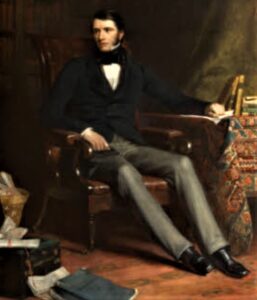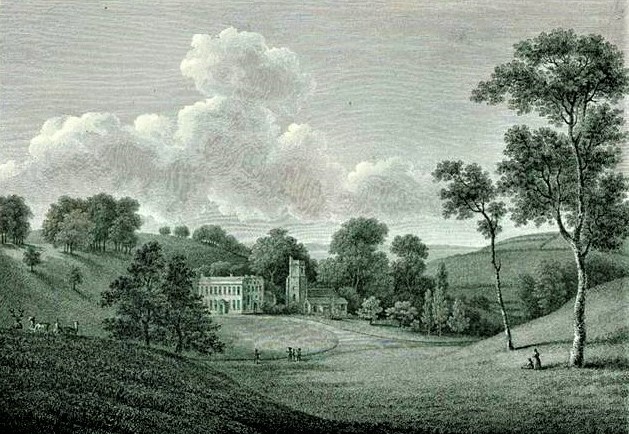Ertach Kernow - Trevelyan family, a dark history
Cornish surnames are found all over the world through the emigration of Cornish miners and families starting in ever increasing numbers from the 18th century. Having just returned from Ireland I was mindful of one in particular, albeit not in the best possible light. Mentioned in song by most Irish singers as part of their pub entertainment Trevelyan is mentioned in the famous Irish protest ballad ‘The Fields of Athenry’ written in 1979 by Pete St John. This is often sung at sporting occasions by Irish fans, and I must say one of my favourite songs.
This ballad is based around the Irish famine of the 1840’s at the same time as what was known in Cornwall as the ‘Hungry Forties’ when similar farming issues and food shortages were taking place. The song tells of the fictional Michael and his wife Mary and their young child. To feed them Michael stole corn and after being caught was convicted and sentenced to transportation to the Australian penal colony at Botany Bay, now part of the city of Sydney.
The lines in the song that concern us here is when Mary is saying ‘Michael, they have taken you away. For you stole Trevelyan's corn. So the young might see the morn. Now a prison ship lies waiting in the bay’. The question is, who was Trevelyan and what were his Cornish connections. The person whom this song mentions was Sir Charles Edward Trevelyan whose name should go down in infamy in Irish history and a disgrace to his Cornish ancestry. He came from an ancient Cornish family that originated in the parish of St Veep in a small settlement called Trewillen from where they took their original name. Humphrey Trevelyan a later descendant on being ennobled and taking his place in the House of Lords took the title Baron Trevelyan, of Saint Veep. This small settlement later became Trevelyan with the family name changing over time. Up until 1965 it was mentioned as a settlement on larger scale maps with the annotation ‘on site of mansion’. The farmhouse occupying the site is Grade II listed dating from the 16th century with later extensions from 1815. The north wing is thought to have been part of a much larger building with possible remains of a hall and cross passage. There is a door with a 15th 16th century granite four-centred arch in rectangular surround with heavy roll mould near the junction with the staircase wing projection. This it seems is part of the historic mansion mentioned on maps. It seems that the property at Trevelyan after a short period outside the Trevelyan family descendants ownership between 1930 and 1951 is now back in again having been rebought by the current residents grandfather. A huge amount of work is being undertaken and obviously a labour of love for this family.
The earliest record of the Trevelyan family starts around 1239 with the marriage of Nicholas de Trevelyan to Margaret Carminow. From this couple the number of descendants increased, along with their wealth and power marrying into other Cornish families with land and money. From the original homestead the family spread throughout Cornwall and were blessed with many sons hence the continuation of the family name over the centuries. A John Trevelyan came to greater prominence during the reign of Henry VI during which the dynastic conflict known to us as the Wars of the Roses took place. Born at St Veep in 1425 he became during the reign of Henry VI Sheriff of Cornwall in 1448 and a knight for Cornwall in the parliament held at Reading in 1452. John married the heiress of a wealthy family Elizabeth Whalesborough in 1452 which brought various estates into the Trevelyan family including those at Basil in Cornwall, Nettlescombe in Somerset and Yarnscombe in Devon. A staunch Lancastrian he had his political ups and downs but came out on top when Henry Tudor came to the throne as Henry VII. Having five sons his descendants were many and the estate at Nettlescombe after eight generations ended up in the hands of George Trevelyan who had supported the Royalist cause during the English Civil War. He was rewarded with a baronetcy in 1661 following the Restoration, which continued until 1976 when it became dormant. The 2th baronet changed the name of the family to Trevelyan from its previous spelling, Trevilian or similar, and it is the later current spelling used throughout this article.
The 3rd baronet of Nettlescombe, Sir George Trevelyan, had inherited through his wife Wallington Castle and estate in Northumberland and on his death his son John inherited the title and property. His third son the Venerable George Trevelyan was rector at Nettlescombe and had three daughters and six sons, four who would enter the church, one becoming a Major-General in the British army and the other son Charles Edward Trevelyan a civil servant. Charles Edward held the post of Assistant Secretary to the Treasury between 1840 and 1859 and later posts in India and was instrumental in reforming the British Civil Service. It is through his tenure at the Treasury that he has become reviled, especially in Ireland, when supposedly due to his economic beliefs he refused to provide government financial and food aid. It wasn’t that Irish food production was bad, it was the blight effecting the potato a staple of poor families that caused the famine, whilst cereal crops was exported to England and beyond. The Corn Laws which had kept corn prices artificially high weren’t repealed until 1846 and included all cereal grains, including wheat, oats and barley. Trevelyan’s feelings towards the Irish can be clearly seen in a letter to an Irish peer ‘the judgement of God sent the calamity to teach the Irish a lesson’. To the Chancellor of the Exchequer Trevelyan wrote ‘The real evil with which we have to contend is not the physical evil of the Famine, but the moral evil of the selfish, perverse and turbulent character of the people’. He never expressed any regret for his actions relating to the Irish famine. Cornwall also suffered from the potato blight and other issues at the same time and what Trevelyan thought about those from his ancestral home is unreported. Meanwhile the Scottish Highland Clearances were still in their second phase with the potato blight there causing severe famine especially throughout the communities of the Hebrides and the western Scottish Highlands. Strangely Trevelyan supported aid in various ways for Scotland writing in September 1848; ‘the people cannot, under any circumstances, be allowed to starve’. He even advocated that Scottish Poor Laws be amended to allow the able-bodied poor to claim relief, he was defeated on this. Trevelyan along with Sir John McNeill had by April 1852 founded the ‘Highland and Island Emigration Society’ to assist with emigration to Australia. This approach has come under criticism from the eminent Scottish historian Sir Tom Devine, Emeritus Professor of Scottish History and Palaeography at the University of Edinburgh. It would appear Trevelyan had a particular dislike for the Irish and unfortunately for the English people his attitude has often been reciprocated by Irish folk through to the present day. When visiting the south and west of Ireland especially I have found when telling folk ‘I’m from Cornwall’ there is a positive response. Trevelyan did well for himself being knighted in 1848 and in 1874 was created the first Trevelyan baronet, of Wallington. Following a cousins death Trevelyan had inherited the Wallington estate in 1879.
Another mark against the Trevelyan family name has recently come to greater public attention. Earlier this year Laura Trevelyan the respected BBC reporter stood down from her job BBC World News America. This was in response to discovery that the Venerable George Trevelyan her four times great grandfather was a slave owner, inheriting sales and plantations in Granada. These had come to him through his father Sir John Trevelyan 4th Baronet of Nettlescombe with his marriage to Louisa Simond in 1757. Compensation for the loss of 1,004 enslaved Africans on six plantations following emancipation by the British government to the family was £26,898, equivalent to some £3 million today. Some 42 Trevelyan descendants have signed a letter of apology and donated £100,000 towards education projects on the island with six, including Laura travelling there to give a personal apology. Laura wrote ‘I left the BBC, after a 30-year career, which was a joy and a privilege, to campaign for reparative justice full-time and encourage Britain to face up to its colonial debt.’
Click Laura Trevelyan image to see her short documentary or title - Confronting my family’s slave-owning past in Grenada
To provide some fairness to the Trevelyan family their wealth was not all down to the Granada inheritance from the Simond family ancestors. The Trevelyan’s had raised themselves up from a small Cornish farm in the 13th century through astute marriages and political manoeuvring through to the mid-18th century when the Granada property became theirs. Looking at this from a Celtic angle perhaps descendants of Charles Edward Trevelyan might consider an apology to Ireland for the woeful attitude of their ancestor and his lack of support for the Irish people during the famine, including some one million deaths. This has created a considerable stain on the family name, which is clearly recognisable for it Cornish origins. Whilst there is great pride amongst folk with eminent Cornish surnames, beware, like the Trevelyan’s it may come with a historical cost.
Following on from the Ertach Kernow article in the Voice of 25th May 2022 ‘The hungry forties’ a video was loaded onto the Association for Cornish Heritage YouTube Channel with the ‘Field of Athenry’ together with the words. A link to the channel can be found by clicking the image.
A short report on our recent Dublin trip can be read by clicking the link Dublin 2023













![[167] Ertach Kernow Heritage Column - 30th August 2023 - Cornish wrestling, Bodmin Keep, LGBTQ+ & museums, Lowender Festival Ertach Kernow Heritage Column - 6th September 2023 - Cornish wrestling, Bodmin Keep, LGBTQ+ & museums, Lowender Festival](https://www.cornwallheritage.com/wp-content/uploads/2023/09/167-Ertach-Kernow-Heritage-Column-30th-August-2023-Cornish-wrestling-Bodmin-Keep-LGBTQ-museums-Lowender-Festival-1-300x294.jpg)